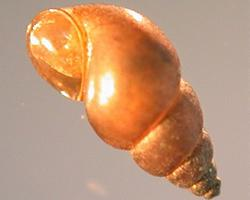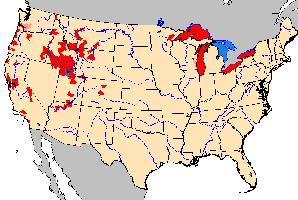
Date biologice
| Numărul de pui | 30 |
|---|
Descrierea animalului
The New Zealand mud snail, scientifically named Potamopyrgus antipodarum, is a diminutive yet ecologically intriguing gastropod mollusk native to the freshwater bodies of New Zealand. Despite its humble size, typically ranging from 4 to 6 millimeters in adulthood, this snail has garnered attention due to its remarkable adaptability and potential impacts on non-native ecosystems.Physically, the New Zealand mud snail is characterized by its dextral (right-handed) coiling shell, which tapers to a pointed apex. The shell's coloration can vary from dark brown to light horn, often reflecting the environmental conditions of its habitat. The snail's small, elongated shell houses a soft body, which it can retract entirely for protection against predators and environmental stressors.
One of the most fascinating aspects of the New Zealand mud snail is its reproductive strategy. In its native habitat, populations can be both sexual and asexual, but in many invaded ecosystems, the snail reproduces asexually through parthenogenesis. This means that a single female can produce a lineage of genetically identical offspring, enabling rapid population growth and colonization. This reproductive efficiency, coupled with a generalist diet that includes detritus, algae, and microscopic plant matter, allows the New Zealand mud snail to thrive in a wide range of freshwater environments.
The snail's diminutive size and hardy nature facilitate its dispersion across and between water bodies. It can easily hitch a ride on the feathers of birds, the fur of mammals, or even the gear of unsuspecting humans, such as fishermen and aquatic recreationalists. Once established in a new location, the New Zealand mud snail can reach astonishing densities, in some cases exceeding 500,000 individuals per square meter. Such dense populations can outcompete native invertebrates for food and space, potentially altering the structure and function of aquatic ecosystems.
The ecological impacts of the New Zealand mud snail are a subject of ongoing research and concern. In invaded areas, such as parts of North America and Europe, the snail can disrupt food webs by competing with native species for resources. Its ability to reproduce rapidly and in large numbers makes it a formidable invasive species, difficult to control once established.
Efforts to manage the spread of the New Zealand mud snail include public education on the importance of cleaning fishing gear, boats, and other equipment that may come into contact with infested waters. Biological control methods are also being explored, though with caution, given the complex interactions within ecosystems and the potential for unintended consequences.
In summary, the New Zealand mud snail, Potamopyrgus antipodarum, is a small but ecologically significant species with a remarkable capacity for adaptation and survival. While it plays a natural role in its native New Zealand ecosystems, its introduction to foreign environments poses challenges to biodiversity and requires ongoing attention and management efforts.
Harta răspândirii

Fotografii noi cu animale
Top 10 animale
- Dolphin gull (Leucophaeus scoresbii)
- Diana monkey (Cercopithecus diana)
- Moustached guenon (Cercopithecus cephus)
- Stone loach (Barbatula barbatula)
- Greek tortoise (Testudo graeca)
- Galápagos tortoise (Geochelone nigra complex)
- Japanese macaque (Macaca fuscata)
- Russian tortoise (Testudo horsfieldii)
- Common flying dragon (Draco volans)
- Galápagos penguin (Spheniscus mendiculus)